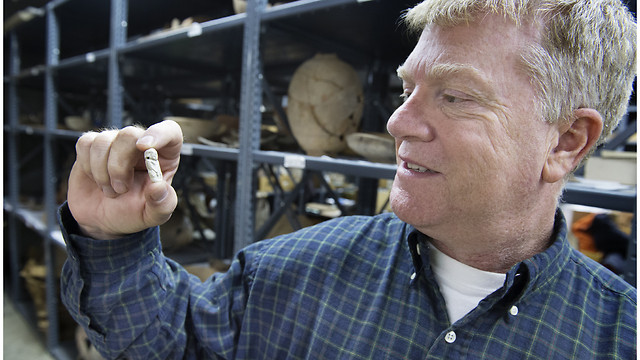
The fragments display marks of an official stamp
University of Wisconsin/Nathaniel Greene
Ancient clay seals reinforce biblical account of early Israel kings
Artifacts thought to date from Iron Age hint at city-state goverment in area previously believed to be entirely rural.
Impressions from ancient clay seals found at a small site in Israel east of Gaza are signs of government in an area thought to be entirely rural during the 10th century BC, says Mississippi State University archaeologist James W. Hardin.

This could indicate that Biblical accounts of David and his son Solomon described real kings rather than the backwater chieftains considered more likely by some archaeologists, said Hardin, an associate professor in the department of anthropology and Middle Eastern cultures.
The six fragments of clay, once used to seal documents or expensive goods, are described in a brief article in the December issue of Near East Archaeology.
"They're little bitty mud balls but they're really important because of what they suggest about what's going on," Hardin, the lead author, said in a telephone interview from the university in Starkville.

The clay fragments are small in size, but could have large significance. (Photo: Photo: University of Wisconsin/Nathaniel Greene) (University of Wisconsin/Nathaniel Greene)
After tying the scroll or other item, ancient officials would wrap part of the string with clay and stamp it with an official seal to show that it had not been opened.
The artifacts are important, said Israel Finkelstein, an archaeology professor at Tel Aviv University. They "probably hint at" a city-state other than that of Gath on the southern coastal plain during the period, he wrote in an email to The Associated Press. Gath was a major Philistine city-state when it was destroyed in the 9th century, according to archaeologists. According to the Bible, it was the home town of Goliath, the giant whom young David laid flat with stone and sling.
But Finkelstein, co-author of a book arguing that "tenth-century Jerusalem was a small highland village that controlled a sparsely settled hinterland" rather than the great kingdom the Bible describes David and his son Solomon as ruling, was unconvinced by Hardin's broader conclusion. It's too far from Jerusalem – about 70 miles – to make connections, he said, and radiocarbon dating for the part of the Iron Age described could be anywhere from mid-10th century to 800 B.C.
"There is no reason to start rewriting history books that come from modern critical research," wrote Finkelstein, who wrote "David and Solomon: In Search of the Bible's Sacred Kings and the Roots of the Western Tradition" with journalist and archaeology historian Neil Asher Silberman.
Carbon dating that period is problematic, Hardin said, so pot fragments from the layers where the bullae were found are being analyzed at the University of Minnesota's Center for Rock Magnetism to see if magnetic analysis can date them more precisely.
They were found at Khirbet Summeily, "a little site in middle of nowhere, outside of Philistia and outside Judah," Hardin said. In modern terms, it's about 14 miles east of Gaza.
Hardin said he first went there three years ago, expecting to find a tiny farming village that might indicate what kind of people lived along a border where fortresses from the 9th and 8th centuries B.C. have been excavated. A village would have been made up of houses with two or three parallel, narrow rooms, each about 8 to 15 feet long, with a broad room across the back; artifacts might include serving dishes and cooking and storage pots, he said.
He was stunned when students turned up not only six broken bullae but a large, beautifully made chalice; a softball-sized figure of an animal's head; scarabs, and several small figurines, possibly of Egyptian gods. Two of those figurines are of turquoise-glazed faience, a sand- or quartz-based ceramic made before clay was glazed and fired.
The brief journal article describes only the bullae, which Hardin said survived because the building burned, accidentally firing the clay.
"My colleague Jeff Blakely worked at Tell el-Hesi – a nearby Iron Age site – during the 1970s and '80s. In our two-and-a-half seasons we've found more Egyptian material than they found at El-Hesi in probably 10 or 12 six-week seasons, digging with anywhere from 50 to 100 people," Hardin said.
The scarabs and figurines likely are from the 11th or 10th century B.C., he said.
He said he and Blakely, an adjunct professor at the University of Wisconsin-Madison's Center for Jewish Studies, had brought 45 to 50 students this year for what was planned as an extensive 5-week dig but had to cut it short. "We got the students out a week or two before the ground war started in Gaza," Hardin said.
He said the building or complex unearthed so far includes at least five or six squarish rooms with walls built on a foundation of river stones. The outer walls have yet to be uncovered.
"We haven't exposed the majority of it yet," Hardin said.
Thinking that at least one bulla might show bits of ancient letters, Hardin brought in Christopher Rollston of George Washington University.
"He looked at them and said, 'You guys don't have letters but you're missing the point. These are high-end, elite-type stamps'" that probably were used to seal written documents, Hardin said.
He said the fragments now are being analyzed to see if they show any microscopic marks from papyrus.










